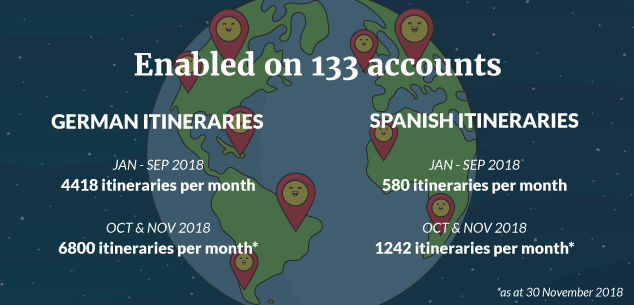The Machine Translations functionality was successfully launched in October and passed the initial testing period with flying Spanish and German colours. Having identified these as the most popular languages of choice among our global clients, we took our content on its first step into the AI space en espanol und auf deutsch. This is the state of Machine Translations now and an excited glance at the way forward.
The situation now..

It’s a modest start with a sample group of operators building amazing itineraries in their clients’ own preferred languages, but early results show a marked increase in the number of Spanish and German itineraries built with Machine Translations over a 2-month period versus a manual translation process over a 9-month period. That’s a lot more output in a much shorter space of time! Also a much wider audience targeted and improved sales prospects.
Early adopters would have found it a fairly quick process with some tweaking required to make up for the finesse a machine translation may lack, but still rendered the functionality a huge time and labour resource advantage over entirely manual translations. These results are correct as at the end of November 2018.
 Where to next?
Where to next?
World domination, what else?
If you think it’s too complicated to do, take a look at this doc and try it out for yourself. See what happens when your itineraries speak the languages of your Spanish and German markets, and let us know.
In the next phase, we’re expanding Machine Translations to include, oui, French and then Dutch. The idea is to roll out the more popular languages in phases to ensure a thorough process of trouble-shooting and testing.
We’re happy to take suggestions for your clients’ preferred languages or the languages of new markets you wish to target, to add to our to-do list for future Machine Translations.
Watch out for French Machine Translations, scheduled for launch before the end of this year and Dutch Machine Translations, scheduled for January next year.🎊


Would you like to share your thoughts?
Your email address will not be published. Required fields are marked *